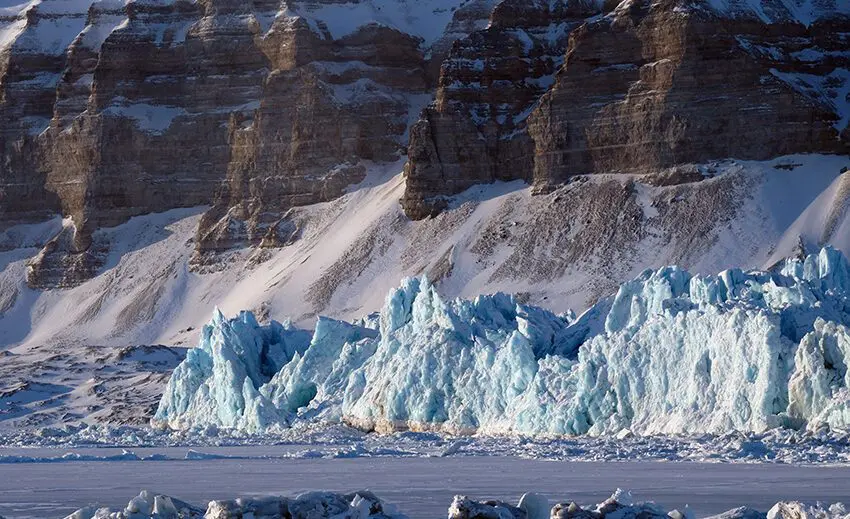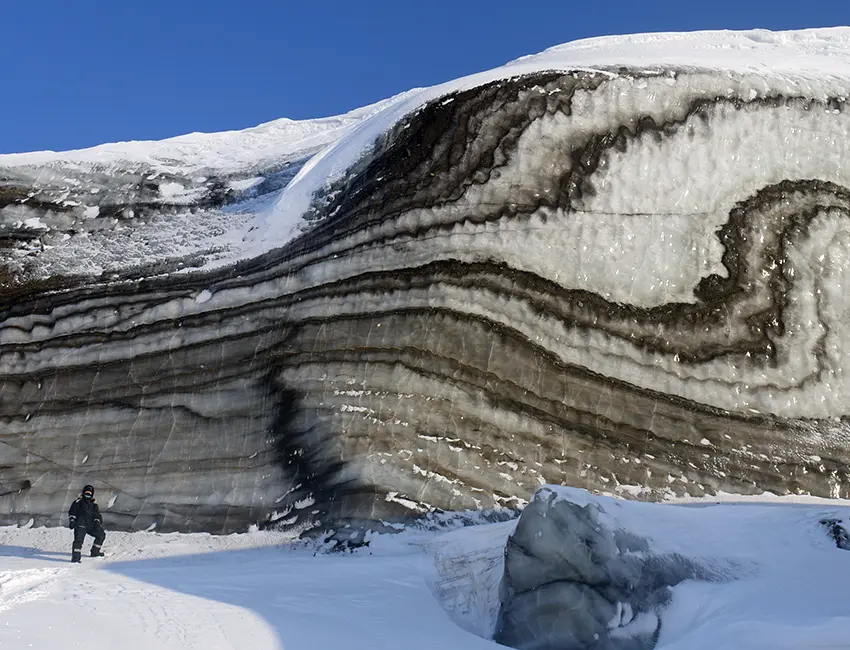AG-325 Glaciology (10 ECTS)
ID:
AG-325
CREDITS:
10 ECTS
APPLICATION DEADLINE:
October 01, 2024
START DATE:
March 03, 2025
END DATE:
April 11, 2025
COURSE PERIOD:
Spring semester. Teaching block 2

Investigating winter advance of the Tunabreen surge following the return of daylight and good sea ice conditions for travel. Photo: Andy Hodson/UNIS
| Grade: | Letter grade (A through F) |
| Course Cost: | None |
| Course Capacity Min/Max: | 12/24 students (AG-325/825 in total) |
| Language of instruction: | English |
| Examination support material: | Bilingual dictionary between English and mother tongue |
Course responsible
Course requirements
Enrolment in a master programme with content that involves glaciology. Background in physical geography, geophysics and/or geology and glaciology is essential. Preference will be given to students working on a Master thesis in glaciology, and so, where possible, please provide the title or a brief description of your Master thesis.
Academic content
The course uses the unique opportunities presented by Svalbard to better understand the characteristics, dynamics and likely fate of contemporary Arctic glaciers. A great emphasis is placed upon monitoring skills development. Lectures will describe how research in Svalbard has developed our understanding of thermally complex Arctic glaciers, and how climate change has strongly influenced this complexity. The impact of thermal change will be a recurring theme, and we will consider its influence upon ice dynamics and hydrological processes in particular. In this way, the relationship between climate, mass balance and glacier dynamics (including surging) can be explored in depth. Monitoring skills development will involve indoor workshops during the first part of the course and intensive fieldwork during the second.
Learning outcomes
Upon completing the course, the students will:
Knowledge
- have a broad-based understanding of glaciological processes, based upon published material and first-hand experience.
- have insight into different approaches to investigating Arctic glaciers using remote sensing and direct field observations.
- understand the response of Arctic glaciers to climate change, and begin to appreciate how their mass balance, thermal characteristics and dynamics will change in future.
- appreciate the importance and limitations of Arctic glacier monitoring during the winter season.
Skills
- develop key observational skills required for modern Arctic glaciology, including field data collection and analysis, image processing and interpretation.
- have logistical and organisational competence relevant to fieldwork during the Arctic winter season.
General competences
- have the ability to write and present a scientific report and a grant proposal
- be able to critically evaluate the published literature given your appreciation of the observational challenges faced by glaciologists working in the Arctic.
- be able to design and implement a short field programme as part of a team.
Learning activities
The course extends for ca. 5 weeks including compulsory safety training.
During the first part of the programme, the course will have a theoretical part with lectures, seminars, computer practicals and field day trips (weather permitting). Then we will conduct an intensive field programme upon two contrasting valley glaciers, followed by lab classes and workshops, wherein we develop communal data resources for the fieldwork reports. A further day trip will be used to ensure students witness more active tidewater glaciers, including surges (if accessible). Students will have the opportunity to introduce their background and thesis at the start of the programme, and then to present the outcomes of the field programme (in groups) in the latter part of the course.
Summary
- Total lecture hours: 24 hours.
- Seminars: 6 hours.
- Lab/exercise hours: 24 hours.
- Fieldwork or field excursions: 4–6 days.
Compulsory learning activities
All compulsory learning activities must be approved in order to sit the exam.
- All exercises
- Field training
- Excursions
Assessment
- All assessments must be passed in order to pass the course.
- Each assessment is graded, and subsequently combined into a single grade. Partial grades for each assessment will be available.
| Method | Length |
Percentage of final grade
|
| Grant proposal | 2000 words | 40% |
| Field report | 2500 words | 60% |
Student life

Photo: Andy Hodson/UNIS
